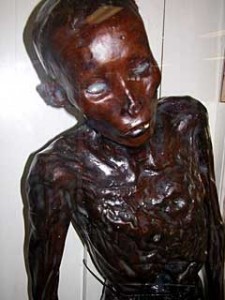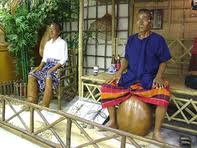
Noted cannibal and Murderer Si Ouey waits for you, under glass, at the museum
What may very well be the world’s grisliest museum isn’t all that hard to get to, as long as you know where it is and what you’re in store for. But if you’re not a medical professional, you might need a strong stomach to get through it. We here at WoWasis first visited here in the early 1990s, heard about some upgrades, and determined it was time to get reacquainted. In our opinion, it’s a museum not to be missed.
Here you’ll see the paraffinned remains of Thailand’s most famous murderer, Si Ouey, hanging in a glassed-in telephone booth-like box. With no signs in English, you don’t recognize his significance. As a prisoner of the Japanese during WWII, he began eating the body parts of dead comrades to keep him alive when food rations were practically non-existant. After the war, he killed Thai children for food, favoring the heart and liver. Today, every Thai of any age knows of Si Ouey. And you get to see him here. The paraffin is starting to ooze out his toenails, dripping black on the pan beneath his feet.
The museum actually exists in three locations on the grounds of Siriraj Hospital, and most river express boats will take you to the Tha Rot Fai pier, on the hospital grounds. The first museum is a tribute to museum staff, and also contains the remains of an ancient boat, found when the old railway station was removed. This museum is not as compelling as the museums in buildings 28 and 27.
Building 28 houses the Forensic Medicine museum (Si Ouey’s retirement home), the Ellis Pathological Museum, and the Parasitology Museum. The Forensic Museum is all about grisly deaths: murders, blast victims, electrocutions, stabbings, bullets to the brain. Where there aren’t whole bodies, there are body parts. One exhibition consists of a brain sliced in half so the trajectory of the bullet can be seen. Across from Si Ouey is a case with bloody female clothing, arranged in anatomical order. These undergarments and outer clothes belonged to Thailand’s most famous murder victim, Nuan Chawi (again, no English signage exists). Nuan was a nurse that had an affair with a married doctor. When she got pregnant, he stabbed her to death, cut her body in pieces, and threw it into the Chao Phraya river (a bridge named after her exists in that place now). The clothes reveal a terrible death, as she was stabbed in the groin area.

Always a crowd-pleaser, everyone likes the big ball diorama in Bangkok’s Pathological Museum
The Ellis Pathological Museum next door provides jarsfull of conjoined babies and fetuses and babies with significant birth defects. The main exhibit in the Parasitology Museum, next door again, consists of the massive testicles of a sufferer of elephantiasis. Not only do you get to see these massive organs encased in glass, but there is a diorama with life-sized statues of a woman and man, she with an elephantiasis leg, he sitting on his testicles, as if they were a chair. Taking photos of anything in these museums is forbidden, but that didn’t stop a young Thai lady from lifting the loincloth of the man to see how everything was connected. We won’t give the secret away.
Finally, building 27 hosts the Anatomy Museum, another can’t miss, and the final stop on your tour. As you enter , look to your right, and you’ll see a room with some skeletons. In the far corner is the skeleton of a 7 foot tall giant, across from several others sporting horrifying leg bone deformities. In the main room are a number of cadavers, including a standing child that suffered from hydrocephalus, brain removed to show the cavity. What you especially don’t want to miss are exhibit numbers 2500, 2497, and 2502. They’re right next to each other, and display a full-sized blood system, nervous system, and muscular system, respectively.
It’s hard not to come away from the Siriraj Medical Museum with some poignant thoughts. We wouldn’t want to die the way those exhibited in the Forensic museum did. We wouldn’t want to have elephantiasis balls. And would we rethink having a child, seeing the multifarious defects so graphically displayed? Mostly, we walked away feeling that we were fortunate, in more ways than we could count.
If the purpose of a museum is to make the visitor think and reflect, this one gets four stars.
Siriraj Medical Museum
Buildings 27 and 28
Siriraj Hospital
Thonburi, Thailand
Take Chao Phraya express boat from any pier to Tha Rot Fai
Admission: 300 baht
Leave a Reply